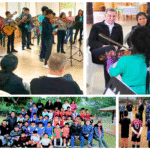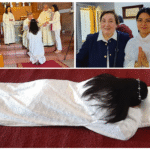
by f. Luis CASASUS, General Superior of the Idente missionaries.
New York, April 12, 2020. | Easter Sunday: The Resurrection of the Lord – Solemnity
Acts of the Apostles 10: 34a.37-43; Letter to the Colossians 3:1-4; Saint John 20:1-9.
Many saints, theologians and masters of spiritual life have made and continue to make admirable efforts to help us understand in a concrete and specific way how to imitate Christ in his various moments: fasting, on the cross, praying, virtues, community life, love of neighbor… But few have succeeded in specifying how we can follow Christ in the resurrection while we are still in this life.
That is why I would like to begin this reflection with these words of our Father Founder, Fernando Rielo:
Before speaking about the resurrection of the body, or the physical resurrection, we must speak of the moral resurrection; but more than moral, we must speak of a mystical resurrection. Sacramental absolution is a moral resurrection, but by virtue of a greater resurrection: the mystical resurrection. I am mystically alive because I am mystically absolved in the sacrament of reconciliation or penance (Feb 3, 1979).
Resurrection is not coming back to life from the dead but involves a profound transformation into a new mode of being that gives one, body, soul and spirit, a new life. And, of course, that cannot be just the effect of own best efforts.
This explains why, writing to the Colossians, Paul reminds them that on the day of baptism they were born to a new life, which has its fulfillment only after this world. Faith in this new life is what differentiates the believers from those who have not had an encounter with Christ, who cannot answer the questions remaining in the depths of the human heart: Why do I live and why do I die? Where do I come from and where am I going? Only Christ who died and rose from the dead can give a satisfactory and useful answer to these questions.
That is why the apostolate is urgent, that is why the people who had received new life from him ran to Jesus’ tomb, knowing that they would always need to be close to Him. Our Father and Founder has called us identes because that is our daily effort: to come close and to bring others close to the person of Christ in a thousand ways. I will not reject anyone who comes to me (Jn 6:37). It is an open invitation. There are no conditions; Jesus wants everyone to come to Him, just as they are.
Deepening the intimate relationship between the sacraments and the resurrection, says our Father Founder:
The Eucharist is the sacrament which, by purifying and rectifying and healing our flesh, makes us in it a preservative from corruption, and a seed or living token of the resurrection. The participation in this wonderful sacrament communicates to human bodies a divine splendor that will persist eternally and give a singular glory to the righteous who have most often received it (Feb 26, 1961).
What actually happens when we partake the Holy Communion is that this Sacrament takes us into the participation or fellowship of the divinity: When we drink from the cup that we ask God to bless, isn’t that sharing in the blood of Christ? When we eat the bread that we break, isn’t that sharing in the body of Christ? (1Cor 10: 16). Partaking of the cup is the participation of the blood of Jesus and the bread is the participation of the body of Jesus. If you do eat my flesh and drink my blood, you will have eternal life, and I will raise you to life on the last day (Jn 6: 54)which tells us anyone who partake this shall live forever. In the partaking of the Holy Communion, you get the life of God in you. With the resurrected life in you, this qualifies you to be a Witness of Resurrection.
Good works, generosity, service, are indispensable, essential. But they are not enough to be a true witness of the resurrection. The testimony is something else. This can only be given by one who passed from death to life; one who can confirm that his existence is completely changed and acquired meaning when it was illuminated by the light of Easter; one who has made the experience that faith in Christ gives meaning to the joys and sorrows and illuminates the joyful and sad moments. One for whom all the moments of his life, all the emotions, the values, the judgments… are different. The key is in the fullness, in the totality of the transformation suffered, because there are infinite beautiful forms of change in people’s lives, but they cannot be called resurrections.
Along with the sacraments, intimacy in prayer is a privileged way to encountering the Risen Lord. Indeed, when we know someone intimately, we can sense the person’s preferences or needs even when we do not see him or her.
A clear sign that we have truly encountered the Lord is when we cannot but be like the disciples in running to announce the resurrection to others. We cannot contain such incredible news in ourselves. After the Easter experience, the disciples could not contain the joy of knowing that Jesus was their Lord and Savior. The lack of the desire to announce that He is risen means that our faith in the Risen Lord is just a cerebral faith, not a personal conviction.
Has our faith in Christ increased and strengthened? Is our relationship with Him real, intimate and personal? Are we joyful and hopeful people in the way we look at life and even when we suffer the trials of life or injustices? Are we a community of love among ourselves and welcoming of others, reaching out to the poor, non-believers or those who have left the Church?
It is good to look at close-up, even next door cases of true spiritual resurrection. Many of you have seen the documentary The Heart of a Murderer (Catherine McGilvray, 2013), which refers to a dramatic real case. The film tells the true story of Samundar, a twenty-two-year-old fanatic Hindu, who in 1995 murdered Sister Rani Maria, a Franciscan missionary nun from Kerala. He stabbed her 54 times and left her to die on the side of the road. Sister Selmy, who lived in community with Sister Rani, was very saddened when she heard about her friend’s horrible death, At least you had your mother and dear friends at the foot of the Cross when you were dying Jesus, my sister died completely alone.
Samundar was subsequently arrested and sentenced to death. In response to Sister Rani’s murderer, her family not only forgives him but they receive him into their family as a son and a brother.
Travelling by train from his village in Northern India on his way to meet Sister Rani’s family, he relives the details of the tragedy, the journey becomes a spiritual awakening for Samundar. He’s transformed from a boy drenched in hate and ignorance to a free man living in love. He is timid and surprised when the family receives him unconditionally with love and forgiveness.
Sister Rani’s mother and sister are women united by love, hurt and peace and they demonstrate an incredible capacity to forgive. Sister Rani’s mother who, initially didn’t support her daughter’s decision to become a religious sister, in the end comes to understand the meaning of her daughter’s death: You’re my son, and I’m glad you came. How is it humanly possible to receive your daughter’s killer into your home? How can you shake his hands knowing her blood was on them?
Swami Sadanand is the peacemaking priest, “where there’s conflict, I will go”, and the first to go visit Samundar in prison. Subsequently, he became Samundar’s spiritual director and father.
The message is intense: forgiveness can truly transform hatred into love. During the course of the film, Samundar calmly tells the story about his radical and progressive conversion from despair, “no one can forgive me. Not even God”, to complete rebirth. Samundar is a true witness to the indispensable and powerful gift that he has received.
—oOo—
The resurrection faith is not only founded on the Empty Tomb. It is necessary to experiment and see how others experience a complete transition from darkness to light. This is captured symbolically in today’s gospel narrative: everything was still dark and the light was just beginning to penetrate the sky when Mary Magdalene came and later Peter approached the empty tomb.
The lives of the disciples were radically transformed, from men of despair and filled with fear to men of hope and courage. to become “witnesses” of Christ, it is not necessary to have walked with Jesus of Nazareth on the roads of Palestine.
Indeed, this is the testimony of Peter when he addressed Cornelius and his household in the First Reading.
Some years ago, a religious person told the story of his 10-year-old niece. She contracted a terrible illness; only three in a million people contract this disease. Eventually all the organs are affected, and there is catastrophic organ failure. This little girl spent much time in the hospital, and she started a prayer journal. She would pray for herself, and her health, but she would also pray for her family and friends at school, and for the little baby in the next room who was also seriously ill. When she passed away, the family looked at her prayer journal. The last entry before she died, the last thing she wrote, the last thing she was thinking about, was expressed in these two words… “also touch.” God, please also touch…. She was touching the world through her prayers, imploring God, “also touch….” As many problems as she had, she was concentrating on being a witness of resurrection. She was praying for new life to come.
When we finish our common Examination of Perfection, we share our Charismatic Touch. The word touch summarizes in a simple way all that God does in us and which we can well describe as a new life, an authentic and complete resurrection. Perhaps it is time to remember that God only works miracles (more or less observable) and everything else is up to each of us.
The resurrection is the permanent work of the Spirit in us. Instead of saying, like the philosopher Seneca, that we die a bit every day, we should be contemplating how we are being resurrected more and more every moment. Mary Magdalene knew this very well, for she had experienced how Christ had cast out seven demons from her life. Like the unnamed disciple of Emmaus, in front of the signs of death, the grave, the bandages, the shroud, our defeated passions … we begin to perceive the victory of life, we begin to understand that if a grain of wheat falls into the earth and dies it produces much fruit.
The healing effects of this resurrection are easy to feel. What happens to our passions, even temptations, is similar to what St. Matthew says about the soldiers who guarded Christ’s tomb: they fell down, as though they were dead. For Christ’s victory it is not necessary, as Peter thought, to draw the sword, but rather to silence our instinct for happiness.
Matthew, Mark and Luke make it clear that Mary Magdalene did not go to the tomb alone. Neither did Peter arrive alone, but with a disciple who many believe was St. John the Evangelist. But both data illustrate how to reach intimacy with God, the most sublime moments of our resurrection, we must do so united as Mary Magdalene, the other Mary, Peter and the unnamed disciple, who undoubtedly represents us all.
Let us find strength and hope from the Risen Lord. Unless we show ourselves alive in Christ, no one would believe that Christ is Risen from the dead. The Good News of Easter can only be announced by those who have felt the Risen Jesus. Only then will the announcement be passionate, permanent and therefore credible.










